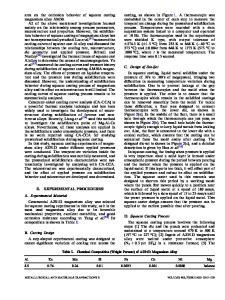Numerical Simulation of Solidification and Prediction of Mechanical Properties in Magnesium Alloy Casting
- PDF / 2,002,616 Bytes
- 13 Pages / 593.972 x 792 pts Page_size
- 35 Downloads / 298 Views
I.
INTRODUCTION AND LITERATURE REVIEW
DIE-CASTING of magnesium–aluminum (Mg-Al) alloys results in varying casting features, which in turn, lead to strength and performance variation throughout different regions in the casting. These variations in mechanical properties are mostly influenced by microstructural features and defects, which develop during the filling and solidification process. Understanding the process of casting could help us to better understand the microstructure and, hence, the performance of the product would be more predictable. Computational tools not only provide assistance for a faster understanding of these variations but also shorten the prototyping sequence for newly developed alloys. A considerable number of publications exist for numerical simulation of phase change problems. Since the focus of this article is not the development of a formulation but rather the utilization of a previously developed formulation by the authors,[1] only a brief literature review highlighting developments in casting simulation is presented here. Among all the literature that is published on phase change and solidification problems, the pioneering works of[2–6] deserve special attention due to the novelty of their formulations. The authors of[2–4] utilized mixture theory, in which each phase is assumed to be a continuum that occupies the entire domain, to define a single-phase macroscopic equation. One of the advantages of this type of formulation is its easy implementation to existing numerical codes.[7] The formulation proposed by Ni and Beckermann[5] and Beckermann and Viskanta,[6] however, is motivated by theories that are applied to flow through porous media and utilizes volume-averaging MEHDI FARROKHNEJAD, CAE Analyst, is with the Department of Product Development and Analysis, Wescast Industries Inc., Brantford, ON N3V 1E7, Canada. Contact e-mail: mehdi.farrokhnejad@ wescast.com ANTHONY G. STRAATMAN, Professor, and JEFFREY T. WOOD, Associate Professor, are with the Department of Mechanical and Materials Engineering, Western University, London, ON N6A 5B9, Canada. Manuscript submitted July 25, 2013. Article published online July 22, 2014. METALLURGICAL AND MATERIALS TRANSACTIONS B
techniques.[8–10] In this type of formulation, the relationship of the various macroscopic and the microscopic terms is clear; hence, the transformation kinetics terms can be coupled to the formulation. This creates a better opportunity to advance the formulation as the insight for solidification processes is enhanced. It is important to mention that with certain assumptions, both formulations could contain the same exact terms.[11] The authors of[12–15] successfully implemented the mixture volume-averaged transport equations of[5] to model solidification of alloys. To implement and derive the mixture momentum equation, in addition to a mixture density and thermal conductivity, the authors assumed a mixture or effective viscosity, which is not, at least in the context of alloy solidification, physically meaningful.[16] Moreover, purely
Data Loading...











